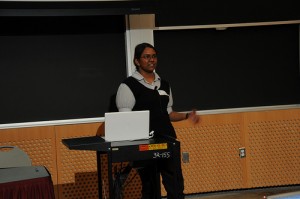
Mario Pena of Safe Creative – Photography by Joi Ito under a (cc) by
Mario covered the basics of registries:
- pointers to works
- facilitate the sharing of relevant information.
- RDFa and ccREL
He also poineted out the need to create communities around registries that allow users to rate works and add to the credibility of the registries. To help contribute to creating standards for registries check out: Open Standards for Copyright Registry Interop.

Joe Benso of Registered Commons – Photography by Joi Ito under a (cc) by license
This presentation focused on the needs for registry authority to be successful. Main features offered by RC , include:
- CC AP,
- time stamping of works (to create a baseline creation date or at least registration date)
- physical identity verification (email verification and Credit Card)
- Moral Rights preferences (this is a large addition beyond the CC basics)
Joe recognized the need for an authority to allocate namespaces, appoint registries based on criteria, identify entities to be certified.
Q&A: How robust are these registries, can they track title and provide authentication of user identities?
The need to track title on copyright could be built into registries and is traditional part of both copyright and patent registrations. Currently title transfer is not supported but this is an option for the future. If registries are build in they right way we should be able to crowd source some of rights clearing. This is essential long term for real commercial viability of CC works.
This was a great session, there were lots of questions. A full day could be dedicated to this topic in a year or two when registries start to mature.
PS: The images in this post are from the last tech summit. Fred Benenson is taking photos at this event and should have them up soon.









